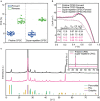Super-Droplet-Repellent Carbon-Based Printable Perovskite Solar Cells
- PMID: 38696594
- PMCID: PMC11234403
- DOI: 10.1002/advs.202401016
Super-Droplet-Repellent Carbon-Based Printable Perovskite Solar Cells
Abstract
Despite attractive cost-effectiveness, scalability, and superior stability, carbon-based printable perovskite solar cells (CPSCs) still face moisture-induced degradation that limits their lifespan and commercial potential. Here, the moisture-preventing mechanisms of thin nanostructured super-repellent coating (advancing contact angle >167° and contact angle hysteresis 7°) integrated into CPSCs are investigated for different moisture forms (falling water droplets vs water vapor vs condensed water droplets). It is shown that unencapsulated super-repellent CPSCs have superior performance under continuous droplet impact for 12 h (rain falling experiments) compared to unencapsulated pristine (uncoated) CPSCs that degrade within seconds. Contrary to falling water droplets, where super-repellent coating serves as a shield, water vapor is found to physisorb through porous super-repellent coating (room temperature and relative humidity, RH 65% and 85%) that increase the CPSCs performance for 21% during ≈43 d similarly to pristine CPSCs. It is further shown that water condensation forms within or below the super-repellent coating (40 °C and RH 85%), followed by chemisorption and degradation of CPSCs. Because different forms of water have distinct effects on CPSC, it is suggested that future standard tests for repellent CPSCs should include rain falling and condensate formation tests. The findings will thus inspire the development of super-repellent coatings for moisture prevention.
Keywords: carbon‐based printable perovskite solar cells; condensate formation test; rain falling tests; screen printing, stability; superrepellent coating.
© 2024 The Authors. Advanced Science published by Wiley‐VCH GmbH.
Conflict of interest statement
The authors declare no conflict of interest.
Figures





References
-
- Kojima A., Teshima K., Shirai Y., Miyasaka T., J. Am. Chem. Soc. 2009, 131, 6050. - PubMed
-
- Best Research‐Cell Efficiency Chart, https://www.nrel.gov/pv/cell‐efficiency.html (accessed: April 2024).
-
- Pescetelli S., Agresti A., Viskadouros G., Razza S., Rogdakis K., Kalogerakis I., Spiliarotis E., Leonardi E., Mariani P., Sorbello L., Pierro M., Cornaro C., Bellani S., Najafi L., Martín‐García B., Del Rio Castillo A. E., Oropesa‐Nuñez R., Prato M., Maranghi S., Parisi M. L., Sinicropi A., Basosi R., Bonaccorso F., Kymakis E., Di Carlo A., Nat. Energy 2022, 7, 597.
-
- Lee K.‐M., Chiu W.‐H., Tsai Y.‐H., Wang C.‐S., Tao Y.‐T., Lin Y.‐D., Chem. Eng. J. 2022, 427, 131609.
-
- Berger E., Bagheri M., Asgari S., Zhou J., Kokkonen M., Talebi P., Luo J., Nogueira A. F., Watson T., Hashmi S. G., Sustainable Energy Fuels 2022, 6, 2879.
Grants and funding
LinkOut - more resources
Full Text Sources
